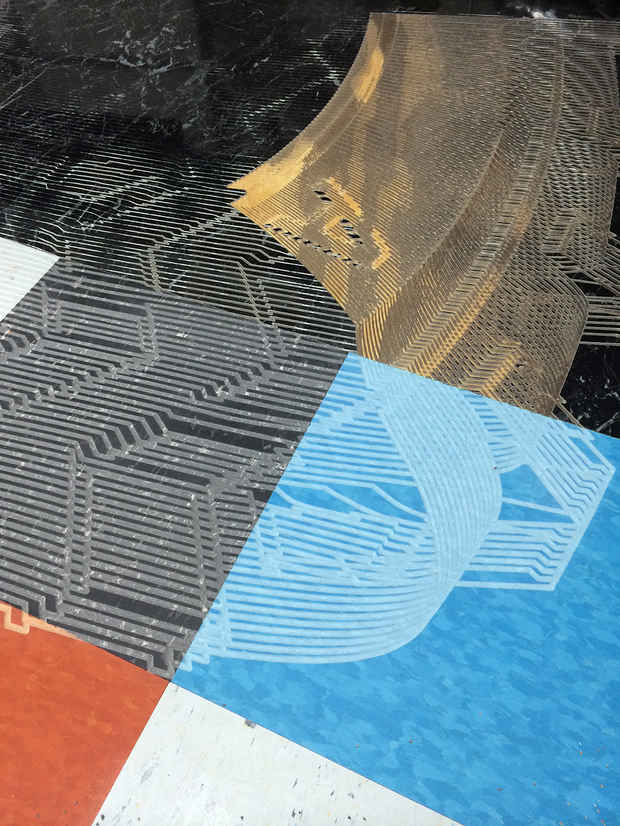“Three Solo Exhibitions”
Derek Eller Gallery

This event has ended.
Derek Eller Gallery presents a three person exhibition of sculpture, wall-works, and installation by David Kennedy Cutler, Michael DeLucia, and David Scanavino.
The three artists negotiate the tension between surface and three-dimensional form in our post- digital age. The potential of converting condensed surface into sculptural space indicates that image itself is not an illusion but emerging as a material in its own right. Image is a material and sculptural space. Cutler, DeLucia, and Scanavino move with ease between the flat, pictorial planes associated with photography and painting, and the undeniable, physical imposition of sculpture. Time and vantage are essential features of their works. Using unit-like components and objects of daily physical interface, these artists contrast image-saturation with the slowness of a body in space. While the singular image epitomizes the economy of flatness, the influence of propositional layering in 3D modeling and computer interfacing has altered perception and the way we navigate our environments.
David Kennedy Cutler’s work begins on a homemade scanning bed. He lays out personal objects: his ubiquitous plaid shirts, his food (vegetables, bread) an art-handling glove (a nod to how he supports himself), printed scans of his apartment and studio floors, of his and his wife’s skin, their bodies intertwined. He then scans this tableau of objects into a digital file on his computer and prints the resulting photograph upon sheets of flat aluminum or cloth. He manipulates these “photos” with his body and rudimentary tools to compose twisting sculptures characterized by pushing and pulling images and form; the digital and the fleshy, dense world of our bodies. Using image as a raw material these works become hyper-representations of his daily interface with the world.
Michael DeLucia’s sculptural medium is the data that he manipulates using Computer Modeling software. His abstract geometries and most recently, stock models (think: clip art or digital ready-made) are constructed from coordinate points, lines and planes forming volumes that are visualized based on artificial suggestions of light, and materiality. The basic elements react to the artist’s hand based on the properties of complex programming languages rather than natural physics or materials structures. The phenomenological fluidity between the screen in the sculptural modeling process and the subsequent violence of the CNC router cutting into plywood is captured in the scarred wall-works and sculptures. The plywood, the ubiquitous domestic building material, often coated with a veneer of marble or wood, is itself an artifice, an abstraction from the original source, a simulacra of natural material. DeLucia’s work stages a conflict between the digital and the physical, and underscores the tension between the abstract and the real. The result is a dissociation between the digital and physical, the real and faux. It is a tension and dissociation that comprises the domestic space and the reality of our built environment.
David Scanavino’s work combines industrial building materials coded with memories of coercive bureaucratic institutions, especially, public school. The nostalgia and potential trauma evoked in the linoleum and colored-construction paper are wedded with the digital aesthetics of the pixel. The solid materials associated with youth and control, become reimagined and experienced in the context of art and aesthetic experience. The dissonance between the aesthetic appeal and art historical relation to Minimalism, and the potential duress the material embodies generates a rich territory of slippage between the aesthetic images and material composing the image. In his handmade paper pulp works, he takes colored construction paper, soaks it in a solution of water and glue-binder, dissolving the material then applying it, in a pain- staking, time-sensitive process of “painting”. The resulting immersive color fields, pixelating with the irresolvable grain of paper pulp, harken to the phenomenology of abstractive expressionism and conceptual fecundity of Félix González-Torres. The works evidence the artist’s hand, but maintain an aggressive stance to the objects in space as their meaning dissipates into a pixilated soup of memory.
Media
Schedule
from May 30, 2014 to June 28, 2014
Opening Reception on 2014-05-30 from 18:00 to 20:00